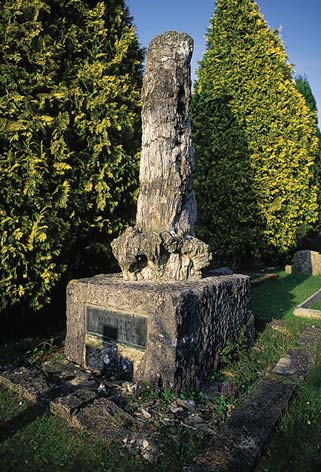A Monument to Modesty
By David Schneider
An effort to restore the grave of Alfred Russel Wallace
An effort to restore the grave of Alfred Russel Wallace

DOI: 10.1511/1999.36.0
Most people credit Charles Darwin with first figuring out how evolution operates, at least in broad outline, citing his 1859 classic The Origin of Species. Serious students of biology learn that Darwin's theory was first presented publicly the previous year, at an assembly of the Linnean Society of London, where a paper with the very same thesis by Alfred Russel Wallace was also read. Despite the gentlemanly device of simultaneous publication, Darwin's name has become almost synonymous with evolution by natural selection, whereas few remember Wallace as more than a footnote.
In actuality, the question of priority for this advance in understanding remains wide open. Over the past few decades, some historians have argued that Wallace (a self-educated naturalist of humble birth and means) in fact beat Darwin (an upper-class gentleman scientist) to the punch.

George Beccaloni
For one thing, Darwin's formulation of the divergence of lineages described in The Origin of Species borrows heavily and without attribution from a scholarly article by Wallace that Darwin had studied years earlier. And whereas Darwin's "paper" presented to the Linnean Society in 1858 was merely a collection of correspondence and unpublished drafts assembled in a hasty effort to demonstrate priority, Wallace's article displayed a clearly reasoned and well-polished argument.
Curiously, neither of the protagonists attended the critical meeting. Darwin was distracted by a serious illness that had struck his household, and Wallace was far away collecting specimens in the Dutch East Indies. When Wallace eventually learned of the parallel manner of publication, he was pleased that his ideas had been so accepted by the scientific establishment. His modesty apparently overwhelmed any resentment he might have reasonably felt over Darwin publishing just then only because Wallace had prepared a powerful article.
But the need to share credit must have stung Darwin. Some telling evidence comes from his letter to Joseph Hooker (a fellow naturalist who helped orchestrate the presentation of the dual papers) soon after that meeting: "I always thought it possible that I might be forestalled, but I fancied that I had a grand enough soul not to care; but I found myself mistaken and punished...."
Far from punishing Darwin, posterity treated his memory well. He is buried in Westminster Abbey, among British royalty and such notables as Newton and Disraeli; his residence at Down House is now a government-run museum. In contrast Wallace's last home was demolished decades ago to make room for apartments. His gravesite, marked shortly after his death in 1913 with a petrified tree trunk for a monument, is now overgrown and difficult even to find.
George W. Beccaloni, a research entomologist at the Natural History Museum in London and self-described "fan of Wallace," managed after considerable effort last year to locate the grave where Wallace is buried. "I was quite horrified by the poor condition it was in," he recalls. So with the help of Wallace's grandson, Richard Russel Wallace, Beccaloni has embarked on a mission to restore the memorial. They want to repair the monument and to install a brass plaque describing Wallace's scientific achievements. They also hope to persuade English Heritage, the government agency charged with historic preservation, to place a marker on the neglected naturalist's one surviving residence, located outside London. "We want to get a preservation order clapped on that before something ghastly happens," notes Richard Wallace.
Others also seem intent to give Darwin's younger competitor his due. Just last year officers of the Linnean Society commissioned a portrait of Alfred Russel Wallace to hang beside their painting of Darwin, and they have offered eventually to take on the lease of the country gravesite. But they have not volunteered the modest funds needed for the restoration. According to Ghillian Prance, director of Kew Gardens and president of the Linnean Society, that group's charter allows monies to be given out only for scholarships and similar forms of academic support.
So Beccaloni is appealing to other Wallace admirers (who can write to him at the Natural History Museum in London or send e-mail to g.beccaloni@nhm.ac.uk). If he is successful, future generations might be induced to learn that much more about this unassuming pioneer of evolutionary theory.—David Schneider
Click "American Scientist" to access home page
American Scientist Comments and Discussion
To discuss our articles or comment on them, please share them and tag American Scientist on social media platforms. Here are links to our profiles on Twitter, Facebook, and LinkedIn.
If we re-share your post, we will moderate comments/discussion following our comments policy.